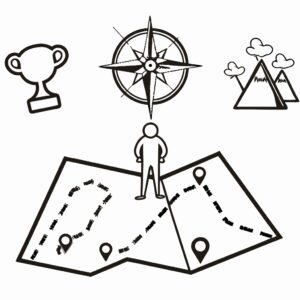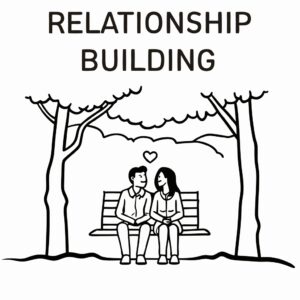
Question More, Action Knowledge.
Remember, at QMAK, we don’t just teach; we empower. We don’t just inform; we inspire. We don’t just question; we act. Become a Gold Member, and let’s unlock your child’s full potential, one question at a time.
In the complex tapestry of life, we often find ourselves faced with perplexing problems and elusive solutions. When our usual ways of thinking fail to yield results, it’s time to embrace a counterintuitive approach: inversion.
Mastering the art of inversion is a crucial skill for navigating challenges, sparking innovation, and achieving personal growth.
First, we’ll explore the concept of inversion, its various applications, and how it can be harnessed for problem-solving and decision-making. Next, we’ll delve into strategies for nurturing this valuable skill in children, helping them develop a versatile and adaptable mindset that will serve them well throughout their lives.
Inversion can be applied in two primary ways:
1. Proof by Contradiction![]() This method, often used in mathematics and logic, involves assuming the opposite of what you’re trying to prove and then exploring the logical consequences of that assumption. If the consequences lead to a contradiction, then the original assumption must be false. This approach can help us identify flaws in our reasoning and strengthen our arguments.
This method, often used in mathematics and logic, involves assuming the opposite of what you’re trying to prove and then exploring the logical consequences of that assumption. If the consequences lead to a contradiction, then the original assumption must be false. This approach can help us identify flaws in our reasoning and strengthen our arguments.
2. Avoiding Stupidity Over Seeking Brilliance![]() Instead of focusing solely on how to achieve a positive outcome, this approach emphasizes the importance of avoiding negative outcomes. By asking, “What could prevent me from achieving my goal?” or “What mistakes do I want to avoid?” we can identify potential pitfalls and prioritize actions that minimize risks. This shift in perspective can lead to more robust and resilient strategies.
Instead of focusing solely on how to achieve a positive outcome, this approach emphasizes the importance of avoiding negative outcomes. By asking, “What could prevent me from achieving my goal?” or “What mistakes do I want to avoid?” we can identify potential pitfalls and prioritize actions that minimize risks. This shift in perspective can lead to more robust and resilient strategies.
To better understand the power of inversion, let’s explore some real-world examples:
Marketing Cigarettes to Women![]() In the early 20th century, Edward Bernays, a pioneer in the field of public relations, used inversion to create a successful campaign promoting cigarettes to women. Instead of trying to sell cigarettes within the confines of existing social norms, Bernays envisioned a world where smoking was socially acceptable for women. He then strategically influenced cultural trends to align with this vision, such as associating cigarettes with women’s liberation and encouraging their inclusion in restaurant menus.
In the early 20th century, Edward Bernays, a pioneer in the field of public relations, used inversion to create a successful campaign promoting cigarettes to women. Instead of trying to sell cigarettes within the confines of existing social norms, Bernays envisioned a world where smoking was socially acceptable for women. He then strategically influenced cultural trends to align with this vision, such as associating cigarettes with women’s liberation and encouraging their inclusion in restaurant menus.
Index Fund Investing![]() John Bogle, the founder of Vanguard, revolutionized the investment industry by introducing the concept of index funds. Instead of trying to beat the market through active fund management, Bogle inverted the problem. He recognized the difficulty of consistently outperforming the market and instead focused on minimizing losses due to high fees and poor fund manager selection. By creating low-cost, passively managed funds that tracked market indices, Bogle made investing more accessible and profitable for the average investor.
John Bogle, the founder of Vanguard, revolutionized the investment industry by introducing the concept of index funds. Instead of trying to beat the market through active fund management, Bogle inverted the problem. He recognized the difficulty of consistently outperforming the market and instead focused on minimizing losses due to high fees and poor fund manager selection. By creating low-cost, passively managed funds that tracked market indices, Bogle made investing more accessible and profitable for the average investor.
Teaching children to think inversely is a valuable gift that can enhance their problem-solving abilities and foster a growth mindset.
Here are some strategies for nurturing inversion skills in young minds:
Beyond its applications in problem-solving and decision-making, inversion can also be a powerful tool for personal development.
Here are some ways to leverage this mental model for your own growth:

2. Habit Formation

3. Relationship Building

4. Career Development

Inversion is a powerful mental model that can transform the way we approach problems, make decisions, and navigate personal growth. By thinking backward and considering the opposite of our initial assumptions, we can uncover hidden insights, generate creative solutions, and avoid costly mistakes.
Cultivating the skill of inversion is essential for lifelong learning and success. By encouraging children to embrace this counterintuitive approach and modeling it in our own lives, we can foster a generation of innovative thinkers who are well-equipped to tackle the complexities of an ever-changing world.
So let us embrace the art of inversion, both as individuals and as a society. Let us challenge our assumptions, consider alternative perspectives, and approach problems with a fresh lens. In doing so, we unlock a world of possibilities and pave the way for a future where creative problem-solving and adaptive thinking are the norm.
Remember, sometimes the key to moving forward lies in looking backward. By mastering the art of inversion, we arm ourselves with a powerful tool for navigating the twists and turns of life with greater clarity, resilience, and success.
Objective: To introduce the concept of inversion through a fun, interactive experience.
Objective: To practice inversion thinking through creative storytelling.
Objective: To apply inversion thinking to problem-solving scenarios.
Objective: To practice using inversion thinking in a persuasive context.
Objective: To apply inversion thinking to personal goal-setting and planning.
Tenet offers a mind-bending exploration of inversion as both a literal and conceptual framework for problem-solving.
Through its intricate plot involving time-reversed objects and people, the film demonstrates how approaching problems backward can reveal solutions invisible to forward thinking.
As students follow The Protagonist’s journey to prevent global catastrophe, they witness how inverting conventional cause-and-effect relationships forces new perspectives on problem-solving.
The film’s complex action sequences, where events unfold both forward and backward simultaneously, provide a visceral demonstration of how inversion can reveal hidden patterns and opportunities.
Beyond its literal time inversion, the film challenges viewers to consider how working backward from desired outcomes can illuminate the path forward, making it a powerful tool for understanding how reversing our typical problem-solving approach can lead to breakthrough insights and innovative solutions.
Sometimes to see what lies ahead
You’ve got to turn it on its head
Inversion shows another way
To find the answers for today
Verse 1
As challenges stack up to the skies
Solutions elude us, no matter how wise
But there’s a way to see, with a fresh pair of eyes
Inversion, the key, to break through the disguise
Looking backward, standing tall
Finding answers after all
Sometimes what we need to know
Comes from turning high to low
Pre-Chorus
There’s wisdom in reverse
When forward paths disperse
Chorus
Flip the script, turn it upside down
Inversion, the way to break new ground
Think backward, from the end to start
A counterintuitive work of art
When you’re stuck and can’t break through
Turn it round to find what’s true
Sometimes wisdom hides behind
What you thought you left behind
Verse 2
Proof by contradiction, a logical twist
Assume the opposite, and see what you miss
Avoiding stupidity, over seeking brilliance
Inversion, the path to resilience
Pre-Chorus
There’s wisdom in reverse
When forward paths disperse
Chorus
Flip the script, turn it upside down
Inversion, the way to break new ground
Think backward, from the end to start
A counterintuitive work of art
Bridge
From marketing to investing ways
From setting goals to brighter days
Sometimes the answer that we need
Is hidden in the path we leave
Turn it around…
Verse 3
In personal growth, inversion plays a role
Setting goals, forming habits, taking control
Building relationships, and career navigation
Inversion, the key, to transformation
Chorus
Flip the script, turn it upside down
Inversion, the way to break new ground
Think backward, from the end to start
A counterintuitive work of art
Outro
Embrace the art of turning round
That’s where wisdom can be found
Sometimes the path that seems so wrong
Is where the answers lived all along

Remember, at QMAK, we don’t just teach; we empower. We don’t just inform; we inspire. We don’t just question; we act. Become a Gold Member, and let’s unlock your child’s full potential, one question at a time.